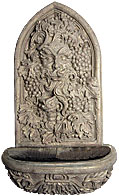We know that wine has to be kept at a low temperature in order to age well. It’s logical—we keep our perishable items cool so that they don’t spoil as quickly, and wine is, of course, a perishable item. But what’s with the humidity thing? Does wine really need to be kept at a certain level of humidity in order to keep from spoiling and aid aging? Or is that just a useless feature that wine cellar makers have convinced us we need? Bottom line: what does a wine refrigerator have that a regular refrigerator doesn’t?
The reason we need a humid environment in which to store wine mostly has to do with the cork. So let’s talk about cork and it’s role in wine storage: Cork comes from cork trees, which are mostly grown in Europe, and so is an organic substance. (Incidentally, cork growing is a completely sustainable type of farming, since the tree is not killed to harvest the cork, and cork forests across the world protect many rare species of plants and animals, not to mention the cork farmers that rely on the trees for their livelihood. Click here if you want to read our argument in support of keeping corks natural.)
Cork is the ideal material for sealing wine bottles, because it can expand and contract as its environment changes. This is particularly useful for wine, because the glass bottles wine is kept in change their shape with the weather—cooler temperature cause the silicon dioxide molecules that make up glass to squeeze closer together, shrinking the bottle. Warmer conditions cause them to spread out, expanding the bottle. Although you want to protect your wine from temperature fluctuations, it is naturally and unavoidably exposed to a variety of environments (when it’s being bottled, when it’s being shipped, and when you’re taking it home from the store, for example). The plastic nature of cork means that it expands and contracts with the glass, maintaining a tight seal between your wine and the outside world.
So, corks are very important for maintaining stable conditions inside your wine bottle. And humidity is essential to maintaining the integrity of a cork. Too dry, and the cork shrinks, letting in too much oxygen and causing cork taint (when a cork is so dry it cracks when you pull it out, the wine is almost certain to be ruined). Too wet, and mold can form on the corks—it can rot them out and taint your wine. (However, a little mold on the outside of a very old bottle’s cork is perfectly normal, as long as the mold is only on the dry side.)
The ideal humidity level at which to store wine is 50%-70% relative humidity. The best kind of humidifiers are generally separate from the cooling systems, although if you live in a humid area or have a certain type of cooling system, you might be ok. Through-the-wall humidifiers are the most heavy-duty choice.
<div class="wp-caption alignright" style="width: 119px">

<p class="wp-caption-text">A wall fountain is one way of adding humidity to a wine cellar.</p></div>
Another very cool option is a fountain humidifier. These work by circulating water through a fountain, allowing it to evaporate into the air and humidify the environment. These wine cellar humidifier fountains can be a unique and aesthetically pleasing part of a wine cellar, and they are sure a conversation starter—no one expects to see a fountain among the dusty bottles. Fountain humidifiers, however, don’t provide as much humidifying power as through-the-wall humidifiers, so if you live in the desert, one might not be an option.
You can learn more about humidifying a wine cellar and types of humidifiers here in our Education Center.
The humidity factor is what differentiates a wine cellar from a refrigerator. The right humidity is crucial to the success of your wine aging endeavors. Humidity needs change from area to area, and humidifiers require that your wine cellar is properly insulated and sealed to work properly, so make sure you contact a wine cellar professional about your specific humidification needs.

 <p class="wp-caption-text">A wall fountain is one way of adding humidity to a wine cellar.</p></div>
<p class="wp-caption-text">A wall fountain is one way of adding humidity to a wine cellar.</p></div>
